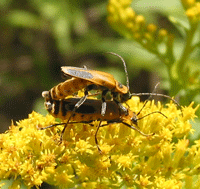 Soldier Beetles copulating on goldenrod flower
Soldier Beetles copulating on goldenrod flower
This lab is an observational study designed to test hypotheses on the mating
behavior of a common species of beetle. First, some background on the theoretical
framework regarding differential mating behavior...
Sexual selection occurs when higher mating success allows some individuals produce
more offspring than other members of the same sex. This is especially interesting
because mating behavior can lead to evolution of characteristics that are independent
of physiological vigor or success in avoiding predators, etc. Like natural selection,
sexual selection can occur in several different patterns. For example, if the
largest individuals in a population are more successful in obtaining mates,
then directional selection will occur, but higher success of "average"
individuals leads to stabilizing selection.
Sexual selection depends on mating that is non-random. Such assortative or non-random
mating has been demonstrated in many vertebrates and invertebrates. In some
cases, it may be attributable to simple physical constraints; for example, a
small beetle may not be able to mate with any male much larger than her. In
other cases, assortative mating may be due to either female choice of males
possessing particular characteristics, or to interactions among individuals
that restrict access to mates. In this exercise we will examine mating patterns
in the cantherid soldier beetle Chauliognathus pennsylvanicus. In general,
we are asking whether mating in soldier beetles is random. From this general
statement emerge the following hypothesis and predictions:
Obviously, there are many other hypotheses and predictions that can be formulated. For this lab, you will test these predictions from these hypotheses. As you are doing your work, think about what other predictions arise from these hypotheses and how you would test them. Your lab notebook should include these other possible predictions and tests.
Chauliognathus pennsylvanicus, the
soldier beetle, is commonly found on yellow flowers in late summer or fall.
The beetle uses the flowers as a source of food (pollen), but the flowers also
serve as a "social focus" for interactions between individual beetles.
Goldenrod (Solidago) is a favored food plant for adults, as are other
late-summer flowering plants.
 Soldier Beetles copulating on goldenrod flower
Soldier Beetles copulating on goldenrod flower
This species has been the subject of several analyses of assortative mating.
In summary, there are many open questions. Some studies have demonstrated directional
selection for larger body size by showing that mated individuals are larger
than non-mated ones. Other analyses have shown that selection occurs only on
some, specific characteristics (not body size per se).
We will work in pairs. The lab has two parts. The first is a 30-minute observation
period during which we will locate soldier beetles on goldenrod (or other yellow
composites) in the butterfly garden and nearby fields. These observations will
help you better understand beetle behavior and may help you interpret the results
of the analyses you will do to assess assortative mating in this species. What
activities can you describe? These detailed observations of interactions between
individual beetles should be in your notebook. Compare activities of individual
beetles to those of pairs. When interactions are seen, distinguish the behavior
of "initiators" (an individual that approaches another within 1 cm)
and "recipients" (the approached beetle). In your lab notebook, record
the behavior, the sex of each individual, and which individual ended the encounter.
Attempt to observe male-female, male-male, and female-female encounters.
During the second part of the lab, each pair will capture and measure a total
of at least 40 beetles in the following distribution: ten mating pairs (10 males,
10 females), 10 solitary males and 10 solitary females. As you capture the beetles,
you will record the (1) sex, (2) width of thorax, and (3) length of the elytra.
Measure the thorax and elytra as indicated below (Figure 1), to the nearest
0.05 mm using Vernier calipers.
 Measuring
width of thorax.
Measuring
width of thorax.
The paper data sheet is double-sided, with one side for recording single beetles
and the other for recording mated pairs. The second (Measure Pair of Beetles)
you should use when you have caught a copulating pair of beetles. Place each
beetle you have measured in a small vial or plastic bag to ensure that no beetles
are measured more than once (Why do we do this?). At the end of the lab, we
will release all beetles back to the wild (to the tune of “Born Free”).
 Measuring
length of elytra
Measuring
length of elytra
SUGGESTED ANALYSES
We are primarily interested in the following questions: (Hypothesis 1) Is there
any significant correlation between male and female sizes for beetles captured
while mating? (Hypothesis 2) Were sizes of copulating male beetles different
from non-copulating males? Use Excel to do the following:
On the web, you can find instructions on how to use Excel to do a Scatterplot and Bar Charts, or for Excel Instructions, in general
In your Lab Notebook, think about the following questions: What would a correlation
between the sizes of copulating males and females mean? Was there a correlation
with your data? How large was the correlation? What were the behavioral interactions
between and within the sexes, and what do they tell us about female choice or
male-male competition, etc? What does it mean if copulaing males are larger
on average than non-copulating males? What other tests could you do to address
these hypotheses?
Rahman N.; Dunham D.W.; Govind C.K. 2002. SIZE-ASSORTATIVE PAIRING IN THE BIG-CLAWED SNAPPING SHRIMP, ALPHEUS HETEROCHELIS. Behaviour. 139:1443-1468.
Hingle A, Fowler K, Pomiankowski A. 2001. Size-dependent mate preference in the stalk-eyed fly Cyrtodiopsis dalmanni. ANIMAL BEHAVIOUR 61: 589-595.